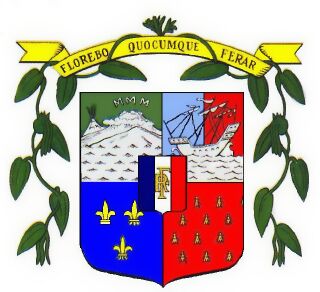Excellent introductions to Réunion Island’s stamps can be
found by clicking here and here, the first by Jim Jackson and the second by Sergio
Sismondo. I won’t repeat what can be found there. Instead, this post discusses
the artwork and heraldry found on Réunion’s stamps.
From the early 20th century onward, French
colony stamps commonly include the artist’s and/or the engraver’s names.
Sometimes the names are incorporated in the stamps design, sometimes they
appear inscribed below the design.
Scott #s 68 (black
and ultra) and 71 (gray green and blue green)
The first such for Réunion were issued in a definitive
series beginning in 1907 and continuing to 1928 with new values, colors and
overprints being added. Two designs incorporate the names of Chauvet and
Puyplat in the engraving. The first, a map of Réunion Island, includes
longitude and latitude markers. In the second, a view of Saint Denis harbor is
flanked by the city’s arms and motto – “praeter omnes angulus ridet” – part of
a quotation from Horace, the whole of which translates “This corner of the earth
smiles for me more than any other.”
The French painter and illustrator Jules
Adolphe Chauvet (1828-1905) is considered the likely artist of the first two
stamps, although they were issued after his death. These are the only stamps
bearing his name. Chauvet’s other artwork is still sold at auctions; he
excelled in architectural drawings and ribald erotica (of the 19th century proclivity).
The name Puyplat is found on stamps much
more commonly than Chauvet. Jules-Jacques Puyplat (1843-1915), a wood-engraving
specialist, is remembered for his magazine and newspaper illustrations as well
as his many stamp designs – for Indochina, Cameroun, Mauretania, Guyana, etc. He
also designed Réunion’s second postage due series. The Societe des Artistes Français inducted
him into membership in 1893.
A third similar design in this series is used for the
higher values and features a view of St. Pierre. It has no signatures. Its
graceful engraving – the bird and waves – suggest
that it may not be from Chauvet’s hand, but possibly from Puyplat’s.
Scott # 97
(red violet)
A second definitive pictorial series with
new artwork was issued beginning in 1933 and continued to 1943, ending with “France
Libre” overprints. While the first series portrays the Indian Ocean and
shoreline, the second draws its inspiration from the island’s volcano-sculpted
interior and a native son, Léon Dierx, a noted French poet born in St. Denis
(1838). Two artists rendered the drawings: Robert Caulet (1906-1984) and C.
Abadie (unknown dates). Both are also credited with the engravings.
A great deal is known about Robert Caulet
– a painter and French Resistance fighter during World War II. He taught at a
St. Denis high School in the early 1930s and his art was exhibited in the Léon Dierx Museum, the entrance of which
he drew and engraved for Scott #s 153//166.
Caulet also produced the view of the
Demoiselles-Salazie waterfall which he likely visited while in Réunion. He also painted
fine china (Sèvres), taught art classes, illustrated books about Africa, and
drew an anti-Nazi comic strip.
One Réunion’s many waterfalls
Little is known about the artist signed as
C. Abadie who drew and engraved Salazie, mare aux poules d'eau et piton
d'Auchain (aka in Scott’s catalog, Walterfoul Lake and Anchain Peak).
He/she is also credited with the graphics for the third postage due series
featuring Réunion’s arms. Perhaps Abadie is someone Caulet met while in Réunion.
Clearly both are accomplished artists. Their philatelic work is limited to
Réunion stamps.
Scott #144
(olive green)
Both Caulet’s and Abadie’s designs were
printed by Institut de Gravure et d'Impression de Papiers-Valeurs, Paris,
a well-known source of philatelic elegance.
Réunion’s arms speak of the island’s beauty and close
connections with France – the mountains and exploding volcano, a 17th
century sailing ship (the St.
Alexis), three fleurs de lis, and a
swarm of bees. It is surrounded by vanilla branches (Vanilla planifolia –
Orchidaceæ), of economic importance to the islanders, and carries the motto Florebo
quocumque ferar (I will flourish wherever I am carried).
Réunion became an integral part of France in 1946 and its citizens, being fully and properly French, have used the stamps of
France since 1975 without surcharges or overprints.
Census: 135 in BB spaces, four tip-ins, 71 on supplement
pages.
Links for first line above.
1 - https://bigblue1840-1940.blogspot.com/2015/04/ClassicStampsofReunion.html



































Thank you for the fascinating history and notes about Reunion and its development as well as its stamps which I find fascinating. Your introduction has prompted an interest which I will need to feed. :)
ReplyDeleteJim and I are always glad to hear we've excited someone's interest.
ReplyDelete